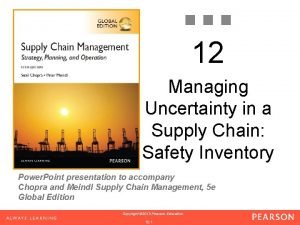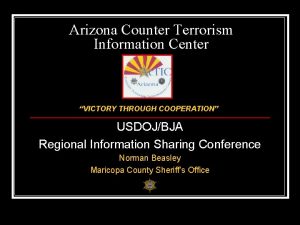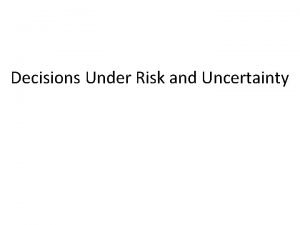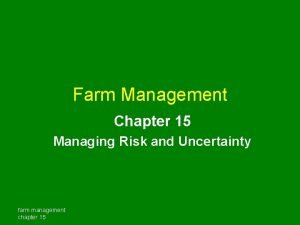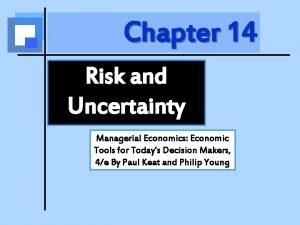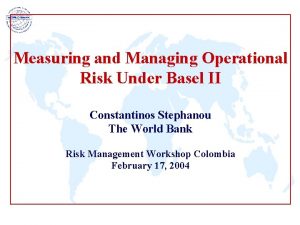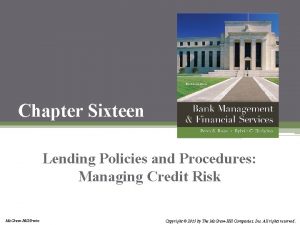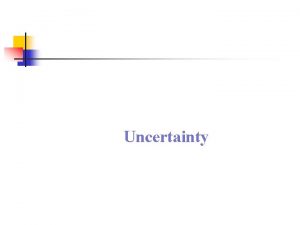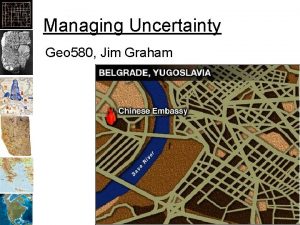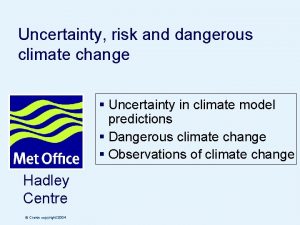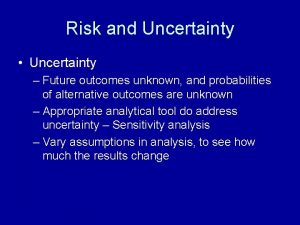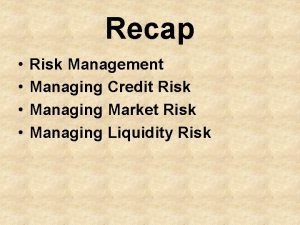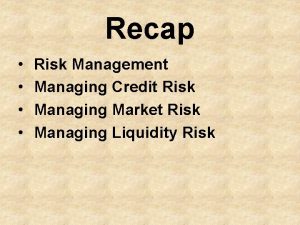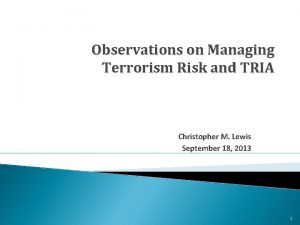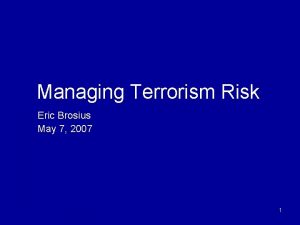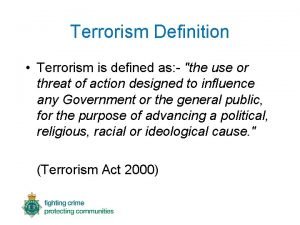Managing the Uncertainty of Terrorism Risk TERRORISM RISK




















- Slides: 20

Managing the Uncertainty of Terrorism Risk

TERRORISM RISK INSURANCE • The September 11, 2001, terrorist attacks created a severe market shortage for terrorism insurance • The US Congress passed the Terrorism Risk Insurance Act (TRIA) as a federal “backstop” for insurance claims related to terrorism events in the US and US interests abroad – It has been extended (with amendments) twice and the current Act is scheduled to expire on December 31, 2014, if not renewed MARSH

How The Act Works $100 B Maximum w/out Congressional Action 15% Company Co-Participation 2007 Renewal (Current In-Force) 85% TRIPRA Coverage Company Retention = 20% of PY DEP $100 M Aggregate Minimum > $5 M Event Certification > Original Policy Deductible MARSH

EVOLUTION OF TRIA/TRIPRA Termination Make-available provision TRIA 2002 TRIA Extension 2005 December 31, 2007 Must make coverage available for certified acts of terrorism No change on same terms and conditions as for other covered risks TRIPRA 2007 December 31, 2014 No change Covered acts Foreign terrorism in the U. S. and on U. S. interests abroad. Includes an act of war for No change workers’ compensation policies only. Foreign and Domestic terrorism in the U. S. and on U. S. interests abroad. Includes an act of war for workers’ compensation policies only. Certification level $5 million No change $5 million in 2006 (thru March 31, 2006) $100 million in insured loss $50 million in 2006 (after in a Program Year March 31, 2006) $100 million in 2007 Program trigger MARSH

EVOLUTION OF TRIA/TRIPRA (CONTINUED) Covered Lines Excluded Insurer Deductible (% of direct earned premium) Federal reinsurance quota share TRIA 2002 Commercial property and casualty (P&C) insurance (including excess insurance, workers’ compensation and surety insurance) Federal crop Private mortgage Financial guaranty Medical malpractice Health or life insurance including group life Flood under NFIA Reinsurance or retro TRIA Extension 2005 TRIPRA 2007 Commercial P&C insurance (including excess insurance, No change workers’ compensation and directors and officers insurance) Added Exclusions: Commercial auto Burglary and theft No change Surety Professional liability Farm owners multiple peril 15 percent in 2005 17. 5 percent in 2006 20 percent in 2007 20 percent 90 percent in 2002 -2005 90 percent in 2006 85 percent in 2007 85 percent Insurance industry retention $15 billion in 2005 for mandatory recoupment $25 billion in 2006 $27. 5 billion in 2007 $27. 5 billion Cap on liability No change MARSH $100 billion

WHAT TO EXPECT • There is limited expectation of TRIA being addressed in Congress until we get closer to the expiration date in 2014 • TRIA has historically received centrist bipartisan support – This could outweigh any far right or left sentiment relative to limiting government involvement in terrorism insurance • Three pieces of legislation have been tabled in the House of Representatives MARSH

Property Terrorism Risk Transfer Solutions MARSH

TERRORISM RISK INSURANCE Terrorism Insurance Take-up Rates By Year MARSH 8

HOW TO PREPARE Strategies for handling potential expiration of TRIA December 31, 2014 • Align property programs with carriers who will continue to support terrorism coverage in the absence of a TRIA backstop to minimize TRIA “sunset” • Consider a standalone terrorism policy as alternative to embedded TRIA – bind a standalone terrorism product to lock in market capacity prior to possible TRIA sunset • Standalone capacity reservation approach – use standalone capacity in excess position with option to “flip” to be primary if TRIA is not extended • TRIA Captive – pre-agreed terms in 2014 to “flip” standalone terrorism reinsurance to be primary and/or enhanced delayed payment coverage conversion • Standalone capacity commitment contracts MARSH

Options for Managing Terrorism Insurance Uncertainty • Secure full term embedded terrorism coverage from All Risk property markets where possible • Stand-alone terrorism market solutions – 100 percent or partial stand-alone terrorism coverage – Capacity commitment contracts – “Flip/Flop” stand-alone terrorism contracts MARSH

Capacity Commitment n Mechanism to reserve capacity prior to 31 st December 2014 n Partial take-up of committed capacity is permitted n Coverage offered on the basis of the T 4/T 4 A or the All Risks policy form MARSH

“Flip/Flop” Stand-Alone Terrorism Contract Post-December 31, 2014 with “Flip/Flop” TRIA with partial Sunset provisions Excess Standalone Terrorism All Risk Full term MARSH Sunset Conversion premium identified on quote

TRIA Captive Program – TRIA expiration strategy Captive TRIA Policy C. Co-Participation 15% Retention Reinsured by the Federal Government TRIA 85% • Captive TRIA Certified Policy: U. S. based captives can act as TRIA authorized insurers and access the U. S. TRIA Federal backstop. TRIA reinsurance offered excess of captive TRIA deductible, captive share can either be retained, subject to sufficient capital, or reinsured with the stand-alone terrorism market. Standalone Terrorism TRIA “wrap”: • A - $100 million TRIA trigger reinsurance B. TRIA Captive Deductible (20% of prior year’s direct earned premium) • B - TRIA deductible reinsurance • C - 15% Co-participation reinsurance • D - Option – Delayed TRIA certification/payment coverage Policy Retention A. Federal Backstop Trigger $100 M MARSH

WORKERS COMPENSATION

UNIQUE ASPECTS OF WORKERS’ COMPENSATION • State regulated and compulsory line of business • Insurers cannot limit or exclude any form of terrorism coverage • Nuclear, Biological, Chemical, and Radioactive perils covered and a significant concern to WC writers – Arguably the most uninsurable risk(s) – Limited reinsurance capacity • Policies written on an unlimited basis MARSH

INSURER REACTION TO PENDING TRIPRA EXPIRATION • The uncertainty of TRIPRA’s future is having an impact on the WC line of coverage; unique because – More granular employer concentration data requirements – Increased scrutiny by carriers on insured employee concentrations – Some insurers have non-renewed WC programs or are only offering short term renewal policies with 12/31 expiration dates to coincide with current TRIPRA expiration • Large risks in NYC are most affected, but problem persists in other major urban cities or for industries such as financial institutions, colleges / universities, hospitals, and defense contractors – Fewer insurer options for buyers and price increases – Contingent endorsements that allow unilateral pricing increases (subject to regulatory approval) are being added to policies MARSH

EMPLOYEE CONCENTRATION RISK Why do employee concentrations matter? • Insurers monitor their concentrations of insured employees on a portfolio basis as well as in concert with other correlated lines of coverage • Insurers “overlined” in certain areas or cities decline risks or impose surcharges on premiums • Concentration data and terrorism catastrophe models have improved, allowing insurers to: – Manage their potential exposures to terrorism loss scenarios – Achieve pricing more reflective of the assumed risk – Satisfy rating agency requirements MARSH

MANAGING THE UNCERTAINTY: WHAT CAN YOU DO? • Be proactive: – Start renewals early – 120 days or more prior to policy effective date • Provide high-quality underwriting data • Use modeling and risk analytics to differentiate terrorism risk profile – Work with risk advisors to develop communication and presentation strategies for key risk exposures MARSH

MANAGING THE UNCERTAINTY: WHAT CAN YOU DO? Highest quality data serves as best differentiator Examples of some additional data elements include: • Building level employee data • Employee marital / dependency status • Employee telecommuting practices and impact on concentration • Physical security of the building including guards, surveillance cameras, parking areas, and HVAC protections • How access to the building is controlled • Construction of the building and location of the offices • Management policies around workplace violence, weapons, and employment screening • Employee security procedures / staff • Emergency response / crisis management plan and procedures • Fire / life safety program MARSH

This document and any recommendations, analysis, or advice provided by Marsh (collectively, the “Marsh Analysis”) are not intended to be taken as advice regarding any individual situation and should not be relied upon as such. This document contains proprietary, confidential information of Marsh and may not be shared with any third party, including other insurance producers, without Marsh’s prior written consent. Any statements concerning actuarial, tax, accounting, or legal matters are based solely on our experience as insurance brokers and risk consultants and are not to be relied upon as actuarial, accounting, tax, or legal advice, for which you should consult your own professional advisors. Any modeling, analytics, or projections are subject to inherent uncertainty, and the Marsh Analysis could be materially affected if any underlying assumptions, conditions, information, or factors are inaccurate or incomplete or should change. The information contained herein is based on sources we believe reliable, but we make no representation or warranty as to its accuracy. Except as may be set forth in an agreement between you and Marsh, Marsh shall have no obligation to update the Marsh Analysis and shall have no liability to you or any other party with regard to the Marsh Analysis or to any services provided by a third party to you or Marsh makes no representation or warranty concerning the application of policy wordings or the financial condition or solvency of insurers or reinsurers. Marsh makes no assurances regarding the availability, cost, or terms of insurance coverage. Marsh is one of the Marsh & Mc. Lennan Companies, together with Guy Carpenter, Mercer, and Oliver Wyman. Copyright 2013 Marsh Inc. All rights reserved. MA 13 -12267
 Managing uncertainty in supply chain safety inventory
Managing uncertainty in supply chain safety inventory Nato definition of terrorism
Nato definition of terrorism Terrorism definition
Terrorism definition Arizona counter terrorism information center
Arizona counter terrorism information center Terrorism
Terrorism Fighting terrorism
Fighting terrorism Terrorism
Terrorism Risk versus uncertainty
Risk versus uncertainty Difference between risk and uncertainty
Difference between risk and uncertainty Capital budgeting under risk and uncertainty
Capital budgeting under risk and uncertainty Uncertainty vs risk
Uncertainty vs risk Risk and uncertainty in farm management
Risk and uncertainty in farm management Calculate certainty equivalent
Calculate certainty equivalent What is risk continuum
What is risk continuum Market risk assessment
Market risk assessment Identifying and managing project risk tom kendrick
Identifying and managing project risk tom kendrick Chapter 1 managing risk when driving
Chapter 1 managing risk when driving Zone control system in driving
Zone control system in driving Measuring and managing operational risk
Measuring and managing operational risk Module 4 topic 1 assessing and managing risk
Module 4 topic 1 assessing and managing risk Lending policies and procedures managing credit risk
Lending policies and procedures managing credit risk
